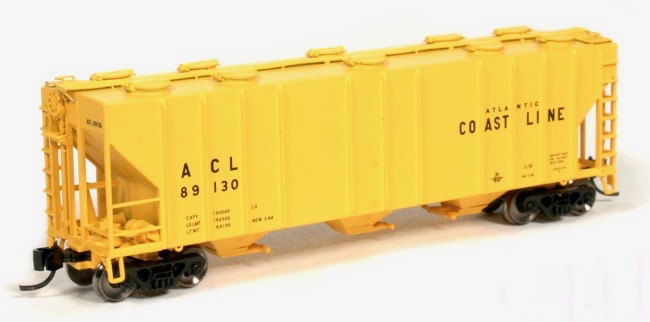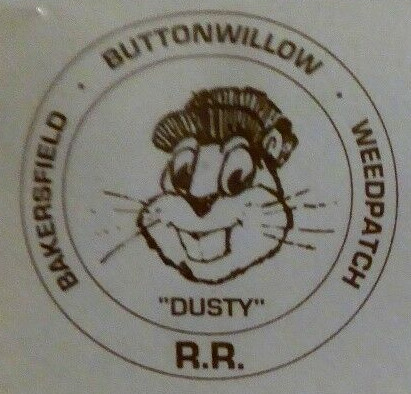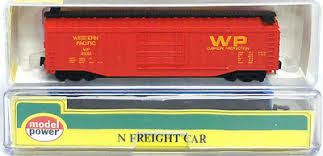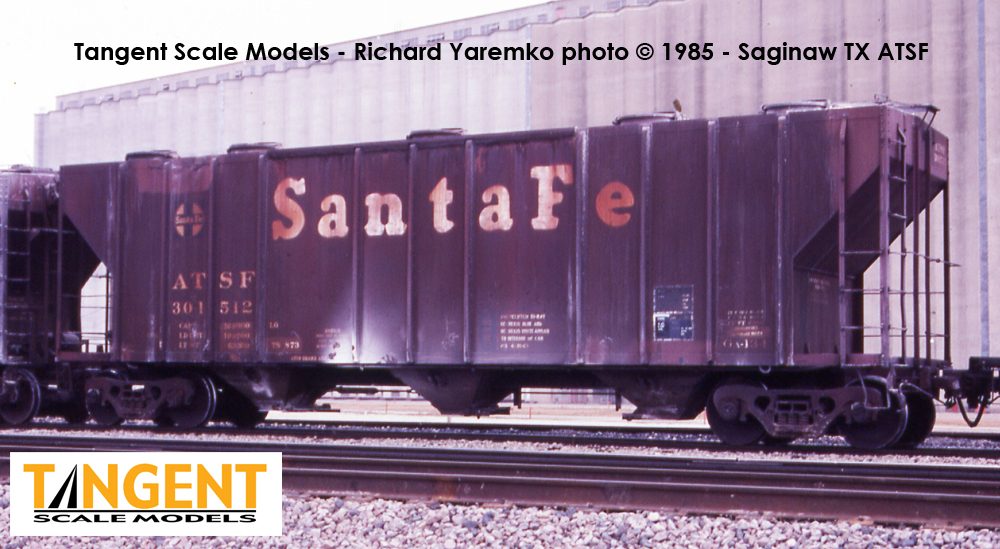Model Information: BLMA first released this model in October of 2009. This was the first appearance of this prototype in N Scale. This model is an excellent example of the company's willingness to push the boundaries of N Scale rolling stock. The brake detail, metal roofwalk and body-mount couplers along with the metal wheels helped set a new standard for N Scale when this model came out. The early BLMA releases feature MTL body-mount couplers whereas the Atlas releases use Accumate couplers. See a video of this model here on YouTube.
Features: Injection-molded plastic body; Fine-scale detail; Checmically etched roof walk and brake platform; Prototypical ride height; Accurately painted and printed; BLMA 100-ton trucks; BLMA 36" metal wheels; Brown knuckle couplers (MTL or Accumate - depending on Brand).
Features: Injection-molded plastic body; Fine-scale detail; Checmically etched roof walk and brake platform; Prototypical ride height; Accurately painted and printed; BLMA 100-ton trucks; BLMA 36" metal wheels; Brown knuckle couplers (MTL or Accumate - depending on Brand).
Prototype History: The PS-2CD 4000 cubic foot covered hopper was produced by Pullman-Standard between 1962 and 1964 in the company’s Butler PA shops. These cars led a very long service life, with some remaining in revenue service throughout the US, Canada, and Mexico until the early 2000s. One of the most distinctive Pullman covered hoppers, this common 90/100-ton car was mostly used in grain, malt, fertilizer, and similar bulk services. Here is a Pullman builder photo of a B&O PS4000.
These cars were built during a transitional period for covered hopper design. It was a time when customers were regularly using 40-foot boxcars for bulk commodity movements, and the inefficiencies of hand-loading and unloading boxcars were becoming issues for customers and railroads alike. Customers wanted faster loading and unloading processes, and railroads wanted the cars back sooner. The PS4000 was one of the first successful bulk commodity designs. The most common production version of these cars featured distinctive round hatches on the roof of the car.
These cars were built during a transitional period for covered hopper design. It was a time when customers were regularly using 40-foot boxcars for bulk commodity movements, and the inefficiencies of hand-loading and unloading boxcars were becoming issues for customers and railroads alike. Customers wanted faster loading and unloading processes, and railroads wanted the cars back sooner. The PS4000 was one of the first successful bulk commodity designs. The most common production version of these cars featured distinctive round hatches on the roof of the car.
Road Name History: ACL’s roots go back to the Petersburg Railroad in 1830. By the 1870s, their successors and some affiliated lines began using Atlantic Coast Line as a nickname and through a number of consolidations Atlantic Coast Line became the official name by 1900.
Atlantic Coast Line funneled traffic from northern Virginia (and its connections to the northeastern trunk lines via the RF&P) down through the Carolinas, Georgia and into Florida as far as Naples on the Gulf Coast. Acquisitions after the war added routes from Columbia and Spartanburg, South Carolina to the coast and lines linking Atlanta, Birmingham and Montgomery to southern Georgia and Florida.
At that point, the Atlantic Coast Line boasted 5,743 miles of railroad, 629 locomotives, 361 passenger cars, and 31,284 freight cars. To put that into perspective for you western guys, that's four times the size of Western Pacific.
ACL was the premier route for New York to Florida passenger traffic. The ACL's "Champion" left New York on the Pennsy, was handed off to the RF&P from Washington to Richmond, ran on the ACL to Jacksonville, FL and was then handed off to Florida East Coast for the ride to Miami. The "West Coast Champion" skipped the FEC as ACL went all the way to Tampa on Florida's Gulf Coast on its own rails. ACL also forwarded some Chicago to Florida trains via connections. Much of the system was relatively flat, allowing ACL to use 4-6-2’s in fast freight service (one of the few railroads to do this.)
ACL is best known for its purple and silver diesels. This scheme was used on freight, passenger, and switcher power until 1957. By that time, it became clear that these colors were difficult to maintain, so the ACL switched to racing stallion black with yellow “tack.” The Atlantic Coast Line merged with the Seaboard Air Line Railroad in 1967 to form the Seaboard Coast Line.
At that point, the Atlantic Coast Line boasted 5,743 miles of railroad, 629 locomotives, 361 passenger cars, and 31,284 freight cars. To put that into perspective for you western guys, that's four times the size of Western Pacific.
ACL was the premier route for New York to Florida passenger traffic. The ACL's "Champion" left New York on the Pennsy, was handed off to the RF&P from Washington to Richmond, ran on the ACL to Jacksonville, FL and was then handed off to Florida East Coast for the ride to Miami. The "West Coast Champion" skipped the FEC as ACL went all the way to Tampa on Florida's Gulf Coast on its own rails. ACL also forwarded some Chicago to Florida trains via connections. Much of the system was relatively flat, allowing ACL to use 4-6-2’s in fast freight service (one of the few railroads to do this.)
ACL is best known for its purple and silver diesels. This scheme was used on freight, passenger, and switcher power until 1957. By that time, it became clear that these colors were difficult to maintain, so the ACL switched to racing stallion black with yellow “tack.” The Atlantic Coast Line merged with the Seaboard Air Line Railroad in 1967 to form the Seaboard Coast Line.
Brand/Importer Information: BLMA Models was founded in July of 2000 to bring Z, N, and HO Scale products of superior quality and originality to the model train community. At BLMA Models, we understand that quality and accuracy count in producing realistic scale models. Our passion revolves around accuracy, diversity, innovation and satisfaction to prototype model railroaders by providing exceptional products and service that goes beyond your expectations.
BLMA was acquired by Atlas Model Railroad in January of 2016.
BLMA was acquired by Atlas Model Railroad in January of 2016.
Item created by: CNW400 on 2021-02-09 14:57:39
If you see errors or missing data in this entry, please feel free to log in and edit it. Anyone with a Gmail account can log in instantly.
If you see errors or missing data in this entry, please feel free to log in and edit it. Anyone with a Gmail account can log in instantly.











